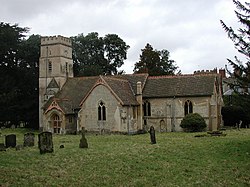Shirburn
| Shirburn | |
| Oxfordshire | |
|---|---|
 All Saints' parish church | |
| Location | |
| Grid reference: | SU697959 |
| Location: | 51°39’27"N, -0°59’33"W |
| Data | |
| Population: | 214 (2011) |
| Post town: | Watlington |
| Postcode: | OX49 |
| Dialling code: | 01844 |
| Local Government | |
| Council: | South Oxfordshire |
| Parliamentary constituency: |
Henley |
Shirburn is a village in the south-east of Oxfordshire, just below the steep escarpment of the Chilterns about a mile north of Watlington and six miles south of Thame. The parish stretches into the hills: the closest spur on the scarp is Shirburn Hill, adjascent to the highest point in Oxfordshire, Bald Hill.
By the village stands the Grade I listed, 14th-century Shirburn Castle, along with its surrounding, Grade II listed park. Also here is a parish church, the oldest part of which is from the Norman period.
Manor and castle
- Main article: Shirburn Castle
Shirburn is a spring line settlement at the foot of the Chiltern escarpment. The Domesday Book of 1086 records that the manor of Shirburn was divided equally between Robert D'Oyly and his brother in arms Roger d'Ivry.[1]
The building of Shirburn Castle was licensed in 1377. It was owned by the Chamberlain family for many generations. [2] The Castle became a centre of Recusancy throughout the 16th and 17th centuries.[1] The castle was renovated and remodelled in the Georgian era by the Thomas Parker, 1st Earl of Macclesfield who made it his family seat, and altered further in the early 19th century; the property is still owned by the Macclesfield family company, although the present (2020) 9th Earl no longer resides there, having been forced by the family company to leave in 2005.[3]
Parish church
Shirburn had a parish church by the 12th century. Between 1146 and 1163 the church seems to have been granted to Dorchester Abbey.[1] The oldest part of today's Church of England parish church of All Saints is the bell tower, which is apparently Norman, except for the 18th-century upper stage.[1] In the 13th century, north and south aisles and arcades were added to the nave.[1]
Thomas Parker, 1st Earl of Macclesfield, Whig politician and Lord Chancellor impeached in 1725, who purchased the castle in 1716 and extensively remodelled it, retired to Shirburn and was buried there after his death in London on 28 April 1732,[4] as were succeeding members of his family.
In 1876 the architect Thomas Henry Wyatt restored the building at the expense of the Earl of Macclesfield.[2] In 1943 All Saints' parish was combined with that of St Mary's, Pyrton. The combined parish is now part of the Benefice of Icknield.[5] All Saints' Church became redundant in 1995 and now belongs to the Churches Conservation Trust.[5]
Railway
In 1869–1872, the Watlington and Princes Risborough Railway was built through the parish with a terminus half a mile south of Shirburn in the parish of Watlington. The Great Western Railway took over the line in 1883. British Railways withdrew its passenger services in 1957 and closed the line to freight traffic in 1961.[6]
Outside links
| ("Wikimedia Commons" has material about Shirburn) |
References
- ↑ 1.0 1.1 1.2 1.3 1.4 Lobel 1969, pp. 178–198.
- ↑ 2.0 2.1 Sherwood & Pevsner 1974, p. 761.
- ↑ Neutral Citation Number: [2003] EWHC 1846 (Ch), accessed 18 December 2012.
- ↑ A. A. Hanham, "Parker, Thomas, first earl of Macclesfield (1667–1732)" (Oxford, UK: OUP, 2004 Retrieved 23 July 2017.
- ↑ 5.0 5.1 The Benefice of Icknield: All Saints Church, Shirburn
- ↑ Oppitz 2000, p. 22.
- A History of the County of Oxford - Volume 8 pp 178-198: Parishes: Shirburn (Victoria County History)
- Oppitz, Leslie (2000). Lost Railways of the Chilterns. Newbury: Countryside Books. pp. 20–23. ISBN 1-85306-643-5.
- Nikolaus Pevsner: The Buildings of England: Oxfordshire, 1974 Penguin Books ISBN 978-0-300-09639-2
